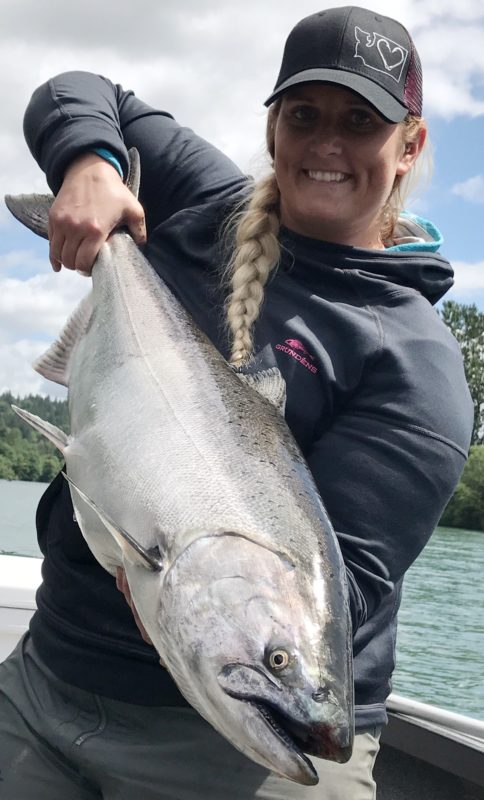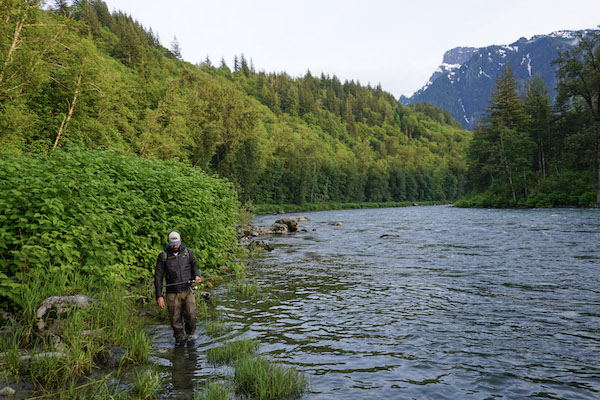
Skykomish: 3 May Days Is It For Summer Kings
Skykomish River anglers will only be able to count on three days to catch hatchery summer Chinook and steelhead late next month below the Wallace, as any fishing after that will depend on the results of an in-season update.

It’s staggering news for what is essentially Puget Sound’s version of the Cowlitz, a dual fishery close to the masses, one that’s powered by snappy hatchery fish, and was also an almighty struggle to approve a new broodstock steelhead program for consumptive opportunities just a few years ago.
“We’ve taken a lot of hits, but we’ve never taken one like this,” said Mark Spada, longtime local angler and member of the Snohomish Sportsmen’s Club this afternoon.
But that’s what the freshwater salmon regulations finally posted to WDFW’s website today show.
Chinook season will run May 27-29 – Memorial Day Weekend – from the mouth of the Skykomish below Monroe to the mouth of the Wallace just upstream of Sultan.
“Continuation of fishery dependent on ISU,” WDFW states without explanation of how that inseason update will be performed. Without sonar, presumably creel monitoring and fishery samplers like out on Puget Sound; maybe tribal test netting?
Daily limit is four Chinook, but only two adults, release wild Chinook.
Outside of those three days, steelheading will apparently also be limited to the Reiter Ponds stretch of the Sky above Gold Bar, but the exact parameters are unclear.
Emails and calls to WDFW Region 4 staff this afternoon were not returned by 5 p.m., or 6 p.m, or 7 p.m., or 8, 9 or 10 p.m. They can explain on their Medium blog or whatever much more clearly to the masses exactly how following this new Puget Sound Chinook management plan is going to result in much more of this. I haven’t been so deeply annoyed with WDFW inre Skykomish salmon issues since 2016’s inability to open the river for coho for lack of an inseason run update tool.

Spada says the Sky’s hatchery Chinook fishery is extremely popular, with guides often booked every day during the run, and says the fish will bite side-drifted offerings, a tactic usually reserved for steelhead.
The heart of the season occurs as snowpack runoff keeps the river relatively cool as well. Some fish are caught in May, as WDFW sport catch card data shows, but mostly they’re landed in June and to a somewhat lesser degree July.
This year’s preseason forecast calls for roughly 7,500 hatchery and 3,400 wild Chinook – the most of both stocks since 2019 – to return to the river, but with expected higher Canadian harvest rates this season relative to last year and with WDFW using its new 10-year Puget Sound management plan’s 8.3 percent low abundance threshold exploitation rate for Snohomish system summer and fall wilds as a whole, there’s just 133 angler encounters available for the stock in what are called “Southern U.S.,” or SUS fisheries – the coast, Puget Sound and the river – constraining the lot of them.
An encounter means hooking and releasing a fish. It’s assumed there’s a 10 percent mortality rate for released salmon. The Snohomish is fed by both the Skykomish and the Snoqualmie Rivers.
Throw in dozens upon dozens of sleds and drifters that will be fishing out of the High Bridge, Sultan, Ben Howard and Lewis Street launches, as well as bank anglers scattered throughout the Sky in hopes of bringing kings and steelhead home for the barbecue, and that 133-fish margin appears perilously small.
So small, in fact, that at this point there won’t even be humpy fishing in the Skykomish in late summer, per WDFW’s season summary.
“I never thought that we’d get to the point where we wouldn’t have a pink salmon season,” said Spada.
What’s more, as it stands, the Snohomish River pink fishery will be delayed until September 16.
Mid-September.
When most of the 642,000 forecasted fish will likely have begun to color up and move into the upper mainstem Snohomish on their way primarily to the Sky.
“Might as well not open it,” Spada said.
There was a harbinger last fall to all of this. WDFW worries about Chinook lingering in the Skagit and Cascade led to coho fishery gear tweaks and opener delays.
Spada termed the Snohomish’s every-odd-year humpy fishery “really, really important” to local tackle shacks like Triangle Beverage in the town of Snohomish.
“They were all gearing up for the pink seasons,” he said.

That was based on initial indications from WDFW, but Spada also describes a series of shifting positions on the fisheries as the annual North of Falcon salmon-season-setting process went on in March and April right into this week.
Still, he was taken back by the breadth of today’s regulations reveal.
“It’s the craziest thing I’ve ever heard,” said Spada.
It’s possible there will be slight tweaks to WDFW’s summary, as there was last week when the agency posted the Puget Sound marine areas synopsis and then needed to correct various listings.
Spada blamed part of today’s bad news for the Skykomish system on low numbers of wild Chinook headed back to the Snoqualmie. That’s a fall stock but is managed in aggregate with Sky summer kings.
It reminded him of how impacts to Stillaguamish River Chinook to the north have heavily constrained salmon fisheries throughout Puget Sound over recent years.
“Now it’s going to be the Snoqualmie,” he said.
As for the Skykomish’s aforementioned integrated summer steelhead broodstock program, that was a heavy lift that also saw WDFW get sued by Wild Fish Conservancy before getting federal approval to release an initial 51,000-plus smolts into the Skykomish in May 2021.
Those fish are expected to begin returning this summer and are a key part of WDFW’s broadly supported Quicksilver Portfolio, which aims to provide a diversity of steelhead angling options across Pugetropolis and has been funded by the state legislature.
Hopefully, with 80,000 smolts having gone out of Reiter Ponds last year for return in 2024, there will be more of a chance to get after them next year.
And that’s about as hopeful a spin as this opportunity-based hook-and-bullet magazine editor who cut his teeth on Skykomish steelhead and salmon fishing can come up with at this hour.
Because otherwise, it really all makes you want to just say, screw it, what is the point of any of this anymore.

